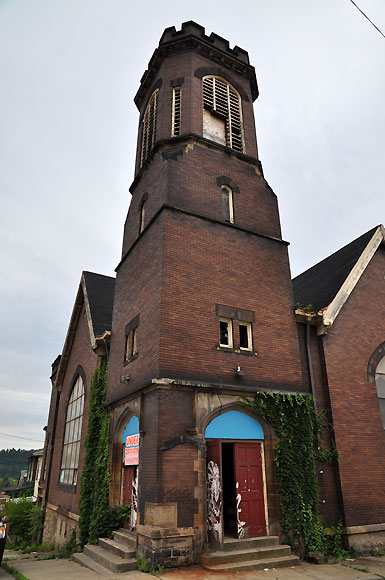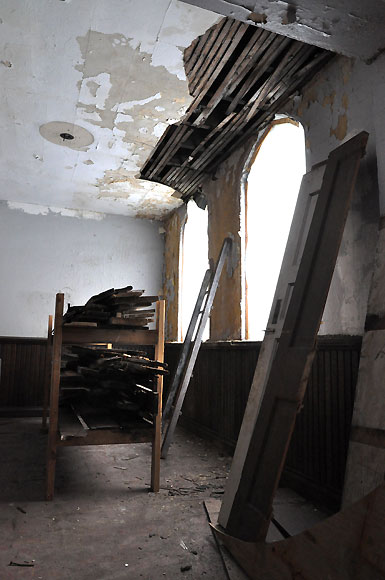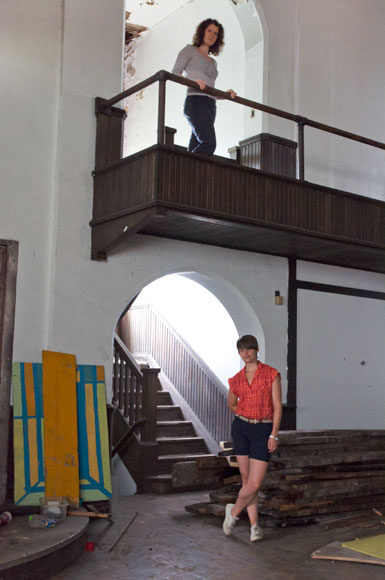
Category Archive: Neighborhood Development
-
Under Deconstruction: Transformazium
Pop City Media
John Farley Wednesday, June 16, 2010

Ruthie Stringer can’t relate to the image of Braddock portrayed in the media. “I think life is more complicated than that,” she says as she sits next to a massive pile of wooden joints in what was once The United Brethren Church in North Braddock. Following a fire that damaged part of the building in 2005, the property sat vacant until Ruthie and her friends purchased it in 2008.
In the Greater Pittsburgh area, over 30% of real estate is vacant or underutilized. Instead of viewing abandoned properties as symbols of blight and despair, Ruthie is taking part in a rapidly growing movement called deconstruction, a sustainable alternative to demolition, which sees opportunity and hope in these properties.
Deconstruction is the selective dismantling of a building for the purpose of reusing the materials to build new structures, and it is this process which Ruthie, along with formerly Brooklyn based artists Leslie Stern, Dana Bishop-Root, and Caledonia Curry (better known as Swoon), are using to turn their building into a community arts center called the Transformazium.
After the Pittsburgh space where Swoon and Leslie were planning an art show two years ago fell through, they were invited to move the show to Lauri Mancuso’s Dorothy 6 space in Braddock, which happened to be located on the first floor of Braddock Mayor John Fetterman’s house. “John showed Swoon the Brethren Church, and she fell in love with it,” explains Leslie.
Swoon, who was busy working on other projects around the world, asked her friends to move to Braddock in order to manage the property. They were able to purchase the building through the Allegheny Vacant Property Act, a form of eminent domain that allows the county to take abandoned properties and clear back taxes, in this case over $500,000, so that new owners can purchase the properties at a reasonable rate.
Shortly after purchasing the building, a friend suggested they attend a conference on deconstruction in Buffalo, NY, co-sponsored by Buffalo Reuse and The Building Materials Reuse Association, a non-profit that serves as a representative for the deconstruction industry, informing people about deconstruction and its benefits.
The Many Benefits
“We spent nine weeks learning about deconstruction, and what it would take to do it, ” says Dana. Instead of demolishing the damaged parts of the Transformazium, they dismantled the reusable materials, which they are using to rebuild other damaged areas of the building. As the Transformazium crew learned, the benefits of deconstruction over demolition are huge. The value of reusable salvaged materials directly offsets high labor costs the donation to Pittsburgh’s Construction Junction in Point Breeze, results in a tax benefit for the building owner. In addition, deconstruction offers major environmental benefits.“All reuse is a form of recycling, but not all recycling is reuse,” says Brian Swearingen, the head of Construction Junction’s deconstruction crew. “In deconstruction and reuse, we’re taking that same material, but using it for the same purpose, or slightly altering it for another purpose. When you do that, you’re saving energy, because you have less transportation costs, less energy costs, and no remanufacturing costs, which are high. A good example is a metal table. If you recycle that at a landfill, you have to put it on a truck, probably put it on a train, possibly put it on a ship, and send it maybe halfway around the world to make what is oftentimes a similar product.”
Construction Junction was set up eight years ago by the Pennsylvania Resources Council to spearhead a movement in Pittsburgh away from disposing waste in landfills without exploring its other purposes. They operate a store, which accepts donations of reusable materials from individuals and businesses renovating or demolishing buildings, and sells those materials at a low cost so they can be repurposed.
In addition to the economic benefits to builders and property owners, deconstruction and reuse provide large incentives for communities. “When you buy materials from Construction Junction, you’re helping provide a cost saving to people who are trying to run their small businesses. You are also helping us employ people to recover materials, which puts money back into the local economy,” Brian explains.
The possibilities of job creation through the deconstruction industry in Allegheny County are exciting. “When we’re asked to do an assessment of deconstruction vs. demolition from a workforce development standpoint, there are times when we could create 20 times more jobs deconstructing buildings than if we demolished them,” notes David Bennink, who will be hosting informational workshops about deconstruction in Braddock on June 17 and 18. David is a BMRA board member, Deconstruction Builder of the Year Award winner, and founder of ReUse Consulting, a 48-person company that performs deconstruction across the country for individuals and businesses, and trains people wanting to start their own deconstruction companies.
Let Me Count the Ways
“The jobs are created in four ways. There’s deconstruction and salvage at the jobsite, there’s processing and transportation, there’s retailing and warehouse like Construction Junction, and finally there’s what we call value added jobs, where we take materials and we add value to them in some way, such as reclaiming wood flooring or making old light fixtures more energy efficient,” says David.If deconstruction sounds like a dream industry, especially for revitalizing cities like Pittsburgh, why isn’t it a more common practice? Why have so few people even heard of it for that matter?
The answer to that question is multifarious, but for David the main problem is a lack of information. Oftentimes, contractors don’t tell property owners about deconstruction, because they fear it will put them behind schedule and cut into their part of the contract. “There are tons of people out there that say to us they didn’t know deconstruction was an option. They just knocked down their building, and they would have chosen deconstruction if they’d known,” he says.
Many people fear that deconstruction is too expensive or time consuming, but deconstruction is frequently faster and cheaper than demolition, and 95% of David’s clients over the past 17 years say they would still prefer deconstruction to demolition.
David and Brian both agree that legislation related to landfills is an obstacle. David is quick to point out that in some parts of the country, dumping fees at landfills are very inexpensive, rendering deconstruction unprofitable in comparison. “We’re always trying to point out that there are hidden costs when you do things too cheaply. An example of that would be if you took a bunch of computer monitors and threw them in the landfill, then naturally you have a hazardous waste problem. And this is a legislative issue, because if you’re doing things too cheaply, you’re passing on hidden costs to the future. That’s not really fair competition,” says Brian.
Despite the roadblocks, people involved with deconstruction in Pittsburgh appear very optimistic about the future. Legislation is evolving. For instance, California and Massachusetts have recently passed bills designed to discourage landfill use for materials that could be repurposed, which could encourage Pennsylvania to adopt similar laws. The Community Regeneration, Sustainability, and Innovation Act, a bill that provides economic support for deconstruction practices, is under consideration in Congress.
“We feel like we’re really onto something here. We’re reaching out to everyone and saying that we believe someday soon, deconstruction will be the main choice for building removal,” says David.
Although a lot of hard work still needs to be done deconstructing and rebuilding the Transformazium, the future seems bright. Swoon lives in Brooklyn, but is currently building an adobe dome in the lot across the street from the Transformazium, which will function as a community greeting space. Leslie, Dana, and Ruthie have completed two large projects that involved the community’s participation. It’s clear that the Transformazium is becoming more than a community arts center, but just what that will be remains uncertain, even to the Transformazium. “We are going to let it evolve more organically, and with input from our neighbors as well. We are definitely working towards a community garden in the lot, though”, says Leslie.
“One of the most exciting shift of perspectives has been realizing that the 15104 area is loaded with resources, and that it’s not simply blighted or abandoned. It’s full of people with a ton of skills and interests, there are several businesses that try very hard and care about the area and people, and there are lots of organizations and spaces.
“But not everyone knows or sees this. Deconstruction has allowed us this shift in terms of looking at all the abandoned buildings and seeing them as having tremendous potential value, instead of just being problems,” Leslie adds.
-
Hill District to Rediscover Itself Via ‘Greenprint’
Wednesday, June 16, 2010By Meredith Skrzypczak, Pittsburgh Post-GazetteHill District residents gathered on a street corner Tuesday as a banner hung above with the words “the village, the woods” written around a picture of the neighborhood.
Plans for community projects that will preserve and sustain the natural and built-up landscape of the Hill were unveiled before the crowd.
Some of those Hill District Greenprint projects include creating a new entrance to Cliffside Park on Cliff Street and a public plaza from Centre Avenue to Kirkpatrick and Centre and Heldman; and cleaning and repairing city steps so residents can move about easily within and outside of the neighborhood.
Terri Baltimore, vice president of neighborhood development for the Hill House Association, said residents of the Hill District should be “rejoicing.”
“A lot of us that live and work in the Hill know the beauty of the neighborhood.”
Phyllis Jackson, 53, has lived on the Hill most of her life and said the projects will bring a new sense of pride to the community.
“We’re trying to put value back in the land,” said Walter Hood, principal of Hood Design and lead consultant for the Hill District Greenprint initiative.
Mr. Wood, who called the Hill one of the greenest pieces of landscape in Pittsburgh, is working with the existing landscape and developing projects that will sustain and transform it.
A Hill District resident for most of her life, Renee Pritchett, 60, said it helps to see the plans. And while there is still work to be done, she said she’s excited that residents can finally start looking ahead with hope for the community.
“Because of outside (negative) influences, it was hard to capture the hope that this brings,” she said. “That has been negated now.”
The project offers an environmentally friendly agenda that will also spark development, said Denys Candy, community development consultant and co-founder of Find the Rivers!, a group that works to develop green spaces in the neighborhood. Most of the projects will hopefully begin within months, he said.
Ms. Jackson said the projects are long overdue, but is happy efforts are finally getting under way.
“We’re doing something today.”
-
Community Groups Seek Input on City Spending
Wednesday, June 16, 2010By Joe Smydo, Pittsburgh Post-GazetteAbout two dozen Pittsburgh residents and community leaders showed up at the City-County Building this morning to demand more public input and other changes to the city’s capital budget process.
Many attended a press conference by Councilman Ricky Burgess, who has introduced bills to ensure that more city dollars are spent in poor neighborhoods and to ensure that community groups get a bigger say in which projects get funded.
Community groups are the “ground troops,” Mr. Burgess said. “They are in the best position to tell us what the needs are.”
Black Political Empowerment Project and North Side Coalition For Fair Housing said they supported Mr. Burgess’ legislation.
Ronell Guy, coalition executive director, said North Side neighborhoods aren’t getting their fair share of city and federal investment dollars, even as other neighborhoods thrive.
“There’s no way we can keep up with the limited resources that we have,” she said.
Councilwoman Natalia Rudiak also has introduced legislation to refine the capital planning process and give the public greater input.
Aggie Brose, deputy director of Bloomfield-Garfield Corp., said she’s pleased that two council members are “singing the same song.”
Both council members’ legislation will be discussed at council’s standing committee meeting today.
-
Brookline School’s Garden Nurtures Students’ Senses
By Jodi Weigand
PITTSBURGH TRIBUNE-REVIEW
Wednesday, June 16, 2010
Jimi Hutchin, 14, sings "God Bless America" with help from Pioneer chorus director Mark Kwolek during a tree-planting ceremony for the Brookline school's sensory garden on Tuesday. Sidney Davis | Tribune-Review
Pioneer school in Brookline on Tuesday formally dedicated one of the area’s first sensory gardens located at a public school.
The gardens provide people with intellectual and developmental disabilities a range of sounds, sights, textures and smells. Pioneer serves about 75 children and adults ages 5 to 21 with rare disabilities and special medical needs.
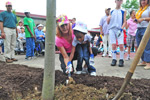
Pioneer school special-education teacher Mary Lou Walczak helps Cache Brown, 8, plant a tree for the school's sensory garden on Tuesday. Sidney Davis | Tribune-Review
“What an important prototype this is going to become for our entire region,” said Judy Wagner, senior director of the community garden and green space program for the Western Pennsylvania Conservancy, which helped design the garden. “This is a very special example of how greenery can really improve the lives of everyone.”
Pioneer’s garden, on about an acre of land in the school’s backyard, has textured plants and brightly colored, fragrant blooms. It features a fountain, hummingbird feeders, swings and benches. Still to be installed are vine canopies over some of the walkways, outdoor musical instruments and raised planters for students to use. A $100,000 grant from the Edith L. Tress Charitable Trust funded the gardens.
“Students will be able to grow fruits and vegetables, and we’ll harvest those for (a course called) activities of daily living, where they learn how to cook and shop and store food,” said Principal Sylbia Kunst. “Our teachers will develop lessons using different parts of the sensory garden.”
Chris Hutchin of Carrick said she’s glad her son Jimi, 14, who has attended the school since 2000, will get to spend more time outdoors.
“A big part of the kids’ growth is being outside,” she said.
When designing the garden, Pioneer officials and the architect sought input from organizations such as the Western Pennsylvania School for Blind Children and Allegheny Valley School, which both have sensory gardens.
“They can encourage imagination or stress release (or) if someone needs to have more stimulation because they’re lethargic,” said Carol Erzen, director of training and staff development at Allegheny Valley School, which provides therapeutic programs to adults and children with disabilities. “It’s a place to truly enjoy nature.”
Kunst said having a secure, handicapped accessible garden at Pioneer will provide more learning opportunities.
“This is another way for our kids to be involved,” she said.
-
Fund Set Up to Pay for Pittsburgh Monument Maintenance
By Pittsburgh Tribune-Review
Tuesday, June 15, 2010
Last updated: 1:33 pmPittsburgh City Council today approved setting up a trust fund to bankroll maintenance to monuments and war memorials in the North Side.
Establishing the account was part of several bills introduced last week by Council President Darlene Harris after people and veterans groups complained that many of the markers had fallen into disrepair.
Harris set aside $40,000 from money left in a 2001 account for projects in her district and money originally dispersed in 1996 for community development for her district.
Council also approved a measure charging the city’s Public Works, Parks and Recreation and City Planning departments to prepare an inventory of the war monuments and memorials throughout the city in order to create a 10-year maintenance plan to be included in the 2011 capital budget.
There are more than a dozen monuments and war memorials in Harris’ district of 13 neighborhoods and more than 60 citywide.
-
Fountains, Graffiti Wall Suggested for Mellon Park Overhaul
By Adam Brandolph
PITTSBURGH TRIBUNE-REVIEW
Tuesday, June 15, 2010Water fountains, more seating, new sidewalks and a graffiti wall were some of the ideas mentioned Monday night as residents met with city officials and community leaders to plan for a major overhaul of Mellon Park in Shadyside.
Despite recently completed work and projects in the planning stage, the meeting at the Third Presbyterian Church in Shadyside brought together interested parties in a single setting for the first time since the original plan was completed in 2002.
“We know this is a park for Shadyside, Squirrel Hill and Point Breeze. … But it’s also a park for Homewood, East Liberty, East Pittsburgh … and people who get off buses to enjoy this park,” said City Councilman Bill Peduto.
The 35-acre park was bequeathed to the city by the Mellon family estate. Its location at the intersection of Penn and Fifth avenues makes the park easily accessible by public transportation.
Recent upgrades include new lighting and a public art installation. Work is nearly complete on a wall garden, and officials spoke last night of new restrooms and a spray park for children.
“Designing a process for a master plan depends on what you want to get out of it,” Susan Radermacher, curator for the Pittsburgh Parks Conservancy, told about 60 people at the meeting. “Always, it should start looking at the history of the place, how it’s being used today and what we’d like to see moving forward.”
Residents voiced concern over noise from the park and limited parking.
“I really hope they can take advantage of all the beauty and the great location of the park,” said Marie Schnitzer of Shadyside. “It’s a wonderful community asset and I think residents not only have plenty of suggestions, but probably the answers.”
-
Scottdale Revitalization Committee Studying Designs for Borough Signs
By Rachel R. Basinger
FOR THE DAILY COURIER
Tuesday, June 15, 2010
Last updated: 7:10 amThe Scottdale Town Center Revitalization Committee is studying the prospect of designing signs for the downtown area of the borough that will help direct visitors as well as provide historic information.
Jim Pallygus, chairman of the board of directors for the STCRC, told council Monday the committee was hoping to put about $3,900 toward the purchase of street signs, historical signs and possibly other types of signs throughout the borough.
“I was hoping we could get permission to begin designing some of the signs, such as the logo, the font, the size, etc., and then when we have something concrete we would bring it back to you for your input or recommendation,” Pallygus said.
Councilman Andy Pinskey presented a motion that requests the STCRC committee work with members of council’s public services committee and then come back to council with recommendations.
In other business Monday, council appointed Michael Mlay to the Parks and Recreation Commission. Pinskey voted against the appointment. Mlay will finish the term of Scott Miller, who recently resigned. The term expires May 1, 2011.
Mlay said he and his wife moved to Scottdale in 2008. He is a high school teacher in Greene County, and his wife is a teacher in the Ligonier Valley School District. He said they moved to the borough because it was a central location to both districts.
“We looked at all the different local communities, and what drew us to Scottdale was the parks,” he said. “There are so many that are so close, and they’re all so beautiful and so nice.”
Because this is now his home, Mlay said he and his wife plan to stay here and want to begin getting involved and setting down roots.
Resident Duane Huffman also had sent the borough a letter of interest about filling the vacancy, but he was not present at the meeting.
Because he was not in attendance to talk about his interest in the position, the majority of council voted to fill the spot with Mlay.
Pinskey said he voted no because Huffman didn’t have the opportunity to talk to council.
Because of the death of Mayor Chuck King’s wife, Nellie King, on Sunday, members of council recessed the meeting after public comment so they could visit the funeral home to give their condolences.
The meeting was recessed at 6:45 p.m.
-
Former School to Become Green Center
Friday, June 11, 2010By Diana Nelson Jones, Pittsburgh Post-Gazette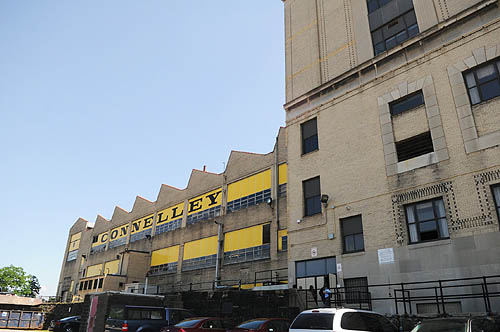
The old Connelly Technical Institute is planned to be used as a business incubator.
The 80-year-old former Connelley Technical Institute in the Hill District is slated to become a green technology demonstration showcase under the ownership of Pittsburgh Green Innovators Inc.
PGI has a sales agreement with Pittsburgh Public Schools and expects to close this summer and begin retooling the former vocational school by fall, said Deno DeCiantis, a PGI board member and director of the Penn State Center, an outreach service for Penn State University in Pittsburgh.

Now vacant, the fifth floor of the "Academic Tower" at the old Connelly Technical Institute contained a full-size commercial kitchen for its culinary students.
The Bedford Avenue school was closed in 2004. It has 220,000 square feet of space. When retrofitted, it will be loaded with green technology to demonstrate function and to absorb the building’s costs.
The prospective new owners envision the site as an incubator of green industry, a job training center for green-industry jobs and a technical support center for work force development.
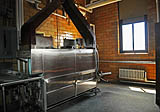
Now used as storage space, the fifth floor of the "Academic Tower" at the old Connelly Technical Institute previously served as a full-size commercial kitchen for its culinary students.
“There are so many jobs that will be created under the broad theme of energy independence,” said state Sen. Jim Ferlo, D-Highland Park, a PGI board member.
PGI is a collaboration of representatives from universities, labor unions, the Green Building Alliance, Hill House and a dozen other entities, plus Mr. Ferlo, state Rep. Jake Wheatley, D-Hill District, and U.S. Rep. Mike Doyle, D-Forest Hills.
Board members led two public tours of the building Thursday, from the spacious top floor with a view of the North Side to the darkened corridors lined with lockers to the ground floor of classrooms that are sky-lit by a sawtooth roof.
State grants of $4 million will enable the organization to create a geothermal pumping system that is expected to provide the building with 65 percent of the energy it will need, said Bill Miller of Pittsburgh Gateways, a nonprofit developer. The extension’s sawtooth roof — each panel of which slants toward the south — “is oriented perfectly for solar panels,” said Mr. DeCiantis.
“There’s nothing we’re doing that isn’t green” Mr. Miller said. Besides the geothermal system, he said, “the rest of our energy will come from solar, wind and microturbines fueled by different energy sources. We will do high-performance glazing, have a green roof, rain gardens and bioswales.”
Mr. DeCiantis said the first phase of retrofitting the building will be under way by fall.
The sales price will be about $200,000, Mr. Ferlo said, because PGI will take over the costs and burdens of remediation and rehabilitation that normally would be required of the seller.
The organization has raised $17 million from public and private donations toward an estimated $16.5 million for first-phase renovations, Mr. Miller said. The entire project will cost about $40 million, he said.
Two years ago, the initiative began establishing an alliance of unlikely collaborators: the Sierra Club, smart-growth advocates, labor leaders and academics.
Anchor tenants will be Penn State and the International Union of Operating Engineers Local 95.
When the project was in the early stage, founding board member Bernie Lynch said the organization’s goal “is to bring all these sectors together to make this an economic hotbed.”


